Wildflowers of the Adirondacks:
Starflower (Trientalis borealis Raf.)
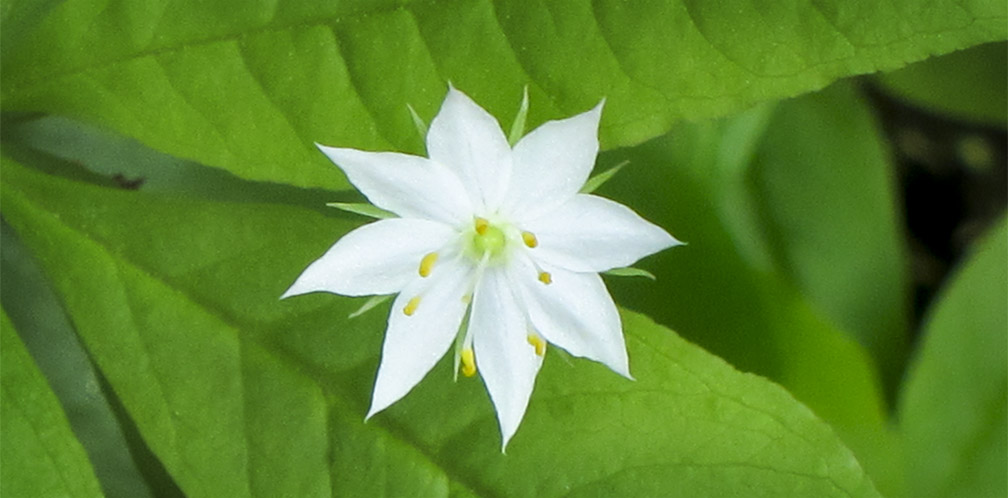
Starflower (Trientalis borealis Raf.) is a low-growing wildflower which produces small, star-shaped white flowers in spring in the Adirondacks of upstate New York.
- The genus name (Trientalis) is from a Latin word meaning one-third of a foot. This is a reference to the height of the plant.
- The species name (borealis) is a reference to north, although this plant also grows in the Midwest and the higher elevations of the southern Appalachian Mountains.
- The author name (Raf.) is a reference to Constantine Samuel Rafinesque, a naturalist born in Constantinople in the late 18th century. He later settled in the US and recorded many new species of plants and animals.
Starflower, which has been categorized as part of the Primrose (Primulaceae) family, is now apparently being merged into other genera in the genus Lysimachia and given a new species name: Lysimachia borealis. This shift was the result of new analyses of molecular and morphological data.
- Other species in the Lysimachia genus which occur in the Adirondacks include Swamp Candles, Creeping Jenny, Fringed Loosestrife, and Tufted Loosestrife.
- The genus name (Lysimachia) may refer to King Lysimachus of Thrace, said to have been the first to discover the styptic and astringent qualities of some of the plants in this genus.
- This shift has not yet been reflected in the Integrated Taxonomic Information System, which still carries this plant as Trientalis borealis Raf. Most sources (including Flora of North America and the US Department of Agriculture) still refer to Starflower as belonging to the genus Trientalis.
The plant's common name (Starflower) refers to the flower's star like appearance. Other common names include Star Flower, Northern Starflower, American Starflower, Mayflower, Star-chickweed, Chickweed Wintergreen, and Star-of-Bethlehem.
Identification of Starflower
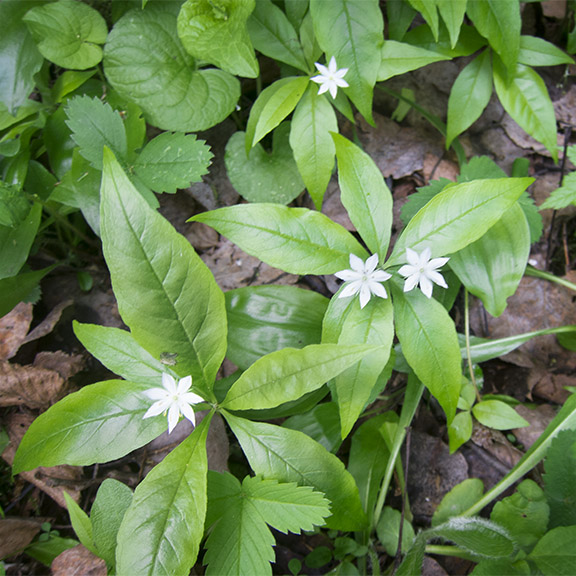
Starflower is a perennial, 4 to 8 inches tall (most typically under six inches). It grows from creeping rhizomes Rhizome: The modified subterranean stem of a plant that sends out roots and shoots from its nodes. Rhizomes are also called creeping rootstalks and rootstocks. and tends to form colonies. The slender stem is usually light green.
Rhizome: The modified subterranean stem of a plant that sends out roots and shoots from its nodes. Rhizomes are also called creeping rootstalks and rootstocks. and tends to form colonies. The slender stem is usually light green.
Starflower leaves vary considerably in size, from 1½ inches to about 4 inches in length.
- Starflower leaves are lance-shaped, tapering to a tip.
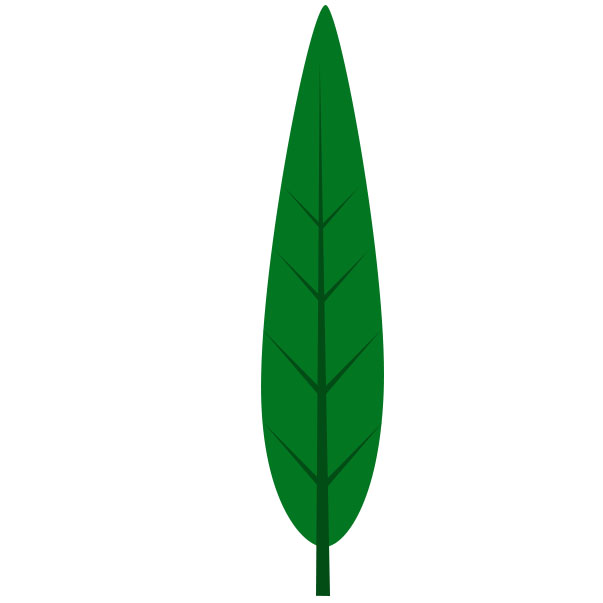 Lanceolate: A leaf shaped like a lance head, tapering to a point at each end.
Lanceolate: A leaf shaped like a lance head, tapering to a point at each end. - The leaves are arranged in a single whorlwith 5 to 9 leaves (most commonly 7) near the top of the stem.
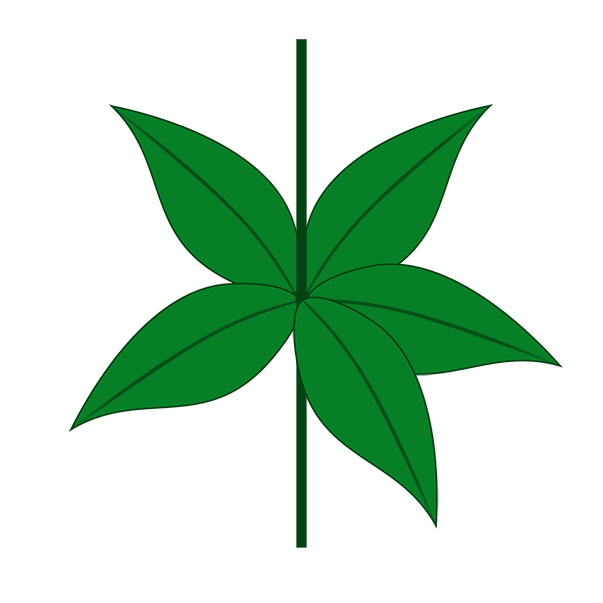 Whorled: Leaves arranged in a circle around a central point.
Whorled: Leaves arranged in a circle around a central point.
- The leaf edges are sm, with no or very fine teeth.
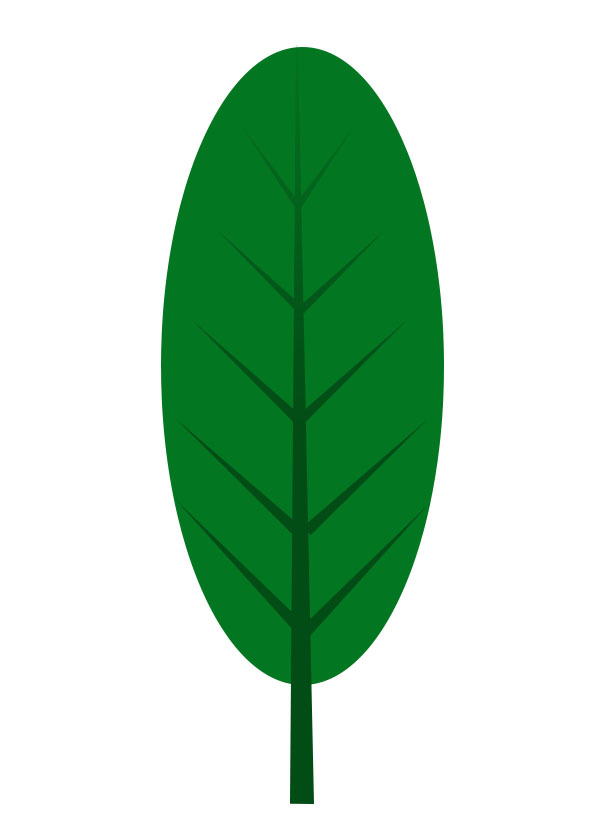 Smooth leaf edges do not have any teeth.ooth
Smooth leaf edges do not have any teeth.ooth -
Leaf venation
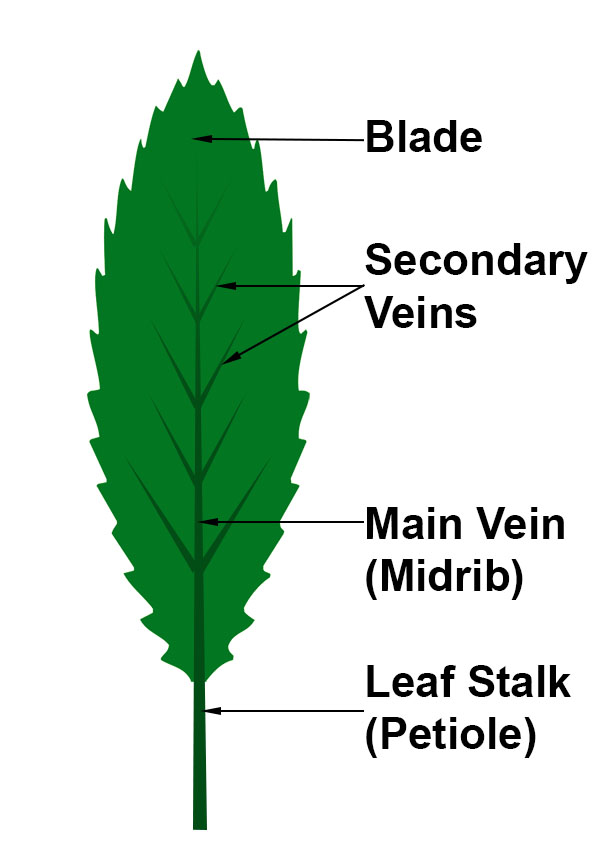 Leaf Venation: The arrangement of veins in a leaf.
is , meaning that there is one main
Leaf Venation: The arrangement of veins in a leaf.
is , meaning that there is one main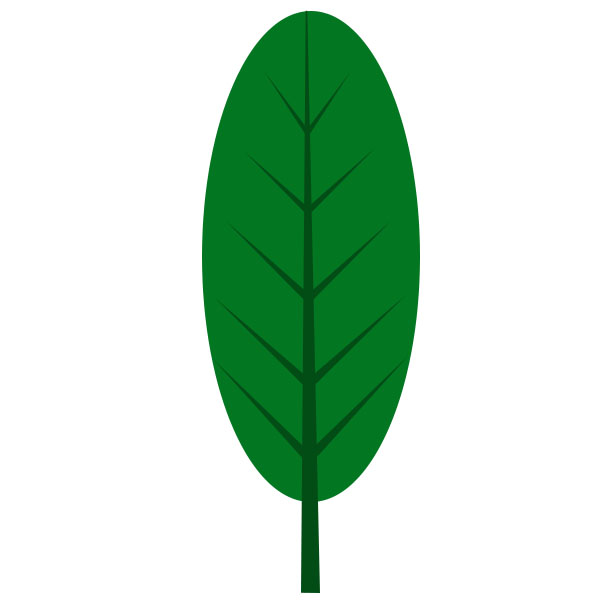 Pinnate Leaf Venation: A vein arrangement in a leaf with one main vein extending from the base to the tip of the leaf and smaller veins branching off the main vein.pinnateveinrunning from the base to the tip and secondary veins branching off at intervals.
Pinnate Leaf Venation: A vein arrangement in a leaf with one main vein extending from the base to the tip of the leaf and smaller veins branching off the main vein.pinnateveinrunning from the base to the tip and secondary veins branching off at intervals. Vein: A vessel that conducts nutrients, sugars, and other substances throughout plant tissues; usually associated with leaves. The arrangement of veins in a leaf is called the venation pattern.
Vein: A vessel that conducts nutrients, sugars, and other substances throughout plant tissues; usually associated with leaves. The arrangement of veins in a leaf is called the venation pattern.
The pattern of the veins is a key to distinguishing the foliage of Starflower from that of Indian Cucumber-root, another low-growing wildflower which shares a similar habitat.
- The dangling, yellowish flowers of Indian Cucumber-root are very different from Starflower flowers; and Indian Cucumber-root usually appears as a two-storied plant, with two whorls of leaves.
- Some Indian Cucumber-root plants, however, are one-storied and can be confused with Starflower when flowers are not present. The vein arrangement is the key to distinguishing the foliage of the two plants. Indian Cucumber-root's leaves have
parallelvenation, meaning that the curving veins run parallel from the leaf base to the tip.
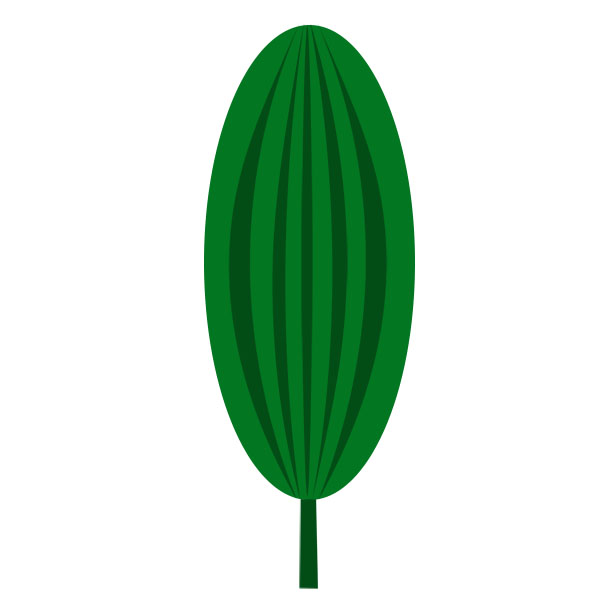 Parallel Leaf Venation: A vein arrangement in a leaf with many veins of similar size running parallel to each other along the length of the leaf.
Parallel Leaf Venation: A vein arrangement in a leaf with many veins of similar size running parallel to each other along the length of the leaf.
Starflower produces one or two snow-white flowers at the top of its slender stalk, just above the whorl of leaves.
- Each flower is about ½ to ¾ inch wide and consists of five to nine petals (most commonly, seven) that form a star-like shape.
- Each flower has 5 to 9 stamens, tipped with yellow on the
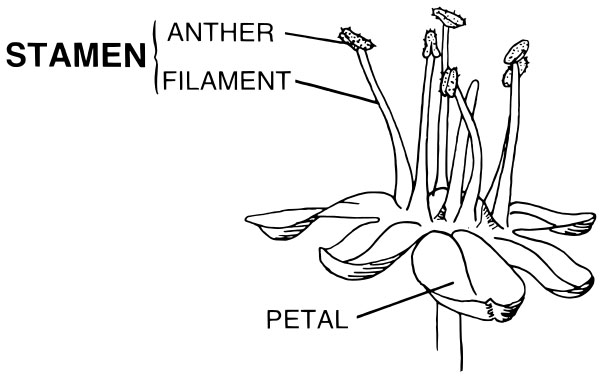 Stamen: The male part of the flower, made up of the filament and anther.anthers.
Stamen: The male part of the flower, made up of the filament and anther.anthers..jpg) Anther: the part of a stamen that contains the pollen.
Anther: the part of a stamen that contains the pollen. - Each flower has 5 to 9 narrow, pointed, light green s, which appear underneath the petals and contribute to the flower's star-like appearance.
.gif) Sepals: The parts that look like little green leaves and cover the outside of a flower bud to protect the flower before it opens.epals
Sepals: The parts that look like little green leaves and cover the outside of a flower bud to protect the flower before it opens.epals
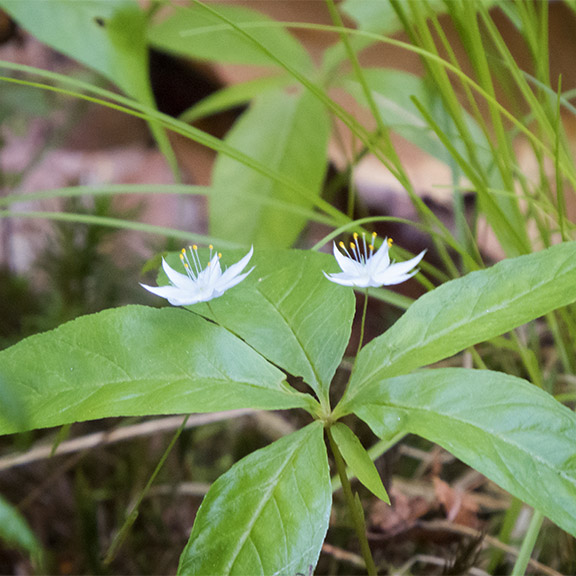
Starflower is a late-spring blooming wildflower. In the Adirondack Mountains, Starflower begins blooming in late May and can be seen in bloom to about mid-June. A tally of flowering dates for the upland Adirondack areas compiled by Michael Kudish, based on data collected from the early seventies to the early nineties, lists the plant as in flower 5 June through 12 June, with the median date as 9 June. Starflower may be in flower as late as 30 June at higher elevations.
The flowers are followed by fruit, which consists of a small, five-celled capsule which changes from green to brown and eventually splits open to release the tiny seeds. Seeds need a cold treatment to germinate.
Uses of Starflower
Starflower has virtually no edible uses and very limited medicinal uses. It was not widely used for medicinal purposes by native American groups. However, several groups are said to have used it as a treatment for ailments of the eye.
Wildlife Value of Starflower
Starflower has limited value to wildlife. The Eastern Chipmunk reportedly consumes some of the seeds or capsules, but this does not constitute a significant portion of its diet. Bees and flies feed on the pollen.
Distribution of Starflower
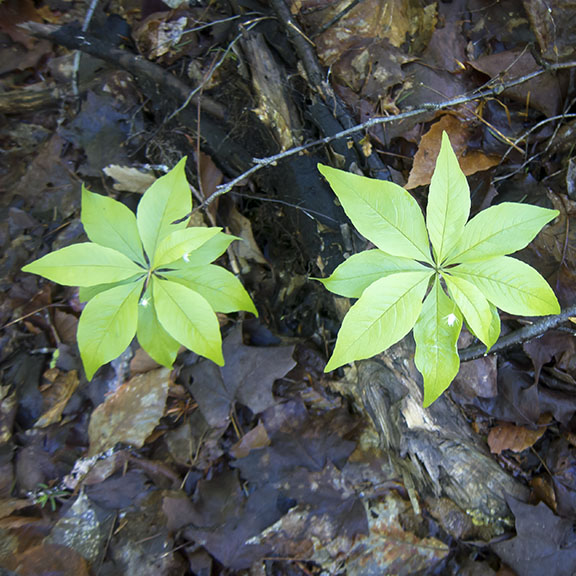
Starflower is one of the most common spring wildflowers in eastern North America and is widely distributed on the North American continent. It occurs in all provinces in the southern half of Canada and all states in the northeastern US, south to Georgia and Tennessee, and in the west coast states south to California. Starflower is listed as Endangered in Georgia and Kentucky, and Threatened in Illinois and Tennessee.
Starflower has been document in most New York State counties in the eastern two-thirds of the state. Starflower can be found in all counties within the Adirondack Park Blue Line except Warren and Saratoga.
Habitat of Starflower
Starflowers are shade-tolerant, with a preference for light shade or dappled sunlight. The plant prefers moist soil, but has been seen growing on well-drained to dry sites. This plant can tolerate acid soils. It grows under both northern hardwoods and conifers. Starflowers will establish themselves in successional old fields that are adjacent to established colonies in old woods.
In terms of habitat, Starflower is relatively flexible, growing in hardwood forests, mixed wood forests, and wetland habitats, in all elevation zones up to (but not including) alpine. This plant is said to be smaller than usual when growing on mountain tops.
In the Adirondack Mountains, Starflower is found in a number of ecological communities:
For instance, the spruce-northern hardwood forest ecological community is a mixed forest often found on mid-elevation slopes or on the margins of swamps.
- In this community, you can find Starflowers growing near Eastern Hemlock, Sugar Maple, Red Maple, American Beech, and Yellow Birch.
- Growing underneath the canopy trees are Striped Maples, the saplings of canopy trees, and shrubs such as Witch Hazel and Hobblebush.
- Characteristic ground-layer plants include Canada Mayflower, Wild Sasaparilla, Partridgeberry, Common Wood Sorrel, Indian Cucumber-root, Foamflower, Purple Trillium, and Pincushion Moss. Hay-scented Ferns and New York Ferns may flourish in canopy gaps.
- Characteristic birds to look and listen for include the Blue-headed Vireo, Black-throated Green Warbler, and Blackburnian Warbler.
Starflowers can be seen on many of the trails covered here, including the Boreal Life Trail and Barnum Brook Trail at the Paul Smith's College VIC, the Peninsula Nature Trails, and several of the Heaven Hill Trails.
References
Michael Kudish. Adirondack Upland Flora: An Ecological Perspective(The Chauncy Press, 1992), pp. 25-28, 148.
Michael Kudish. Paul Smiths Flora II: Additional Vascular Plants; Bryophytes (Mosses and Liverworts); Soils and Vegetation; Local Forest History (Paul Smith's College, 1981), pp. 38, 40-41.
New York Flora Association. New York Flora Atlas. Starflower. Lysimachia borealis (Raf). Retrieved 30 November 2017.
Integrated Taxonomic Information System. Trientalis borealis. Raf. Retrieved 30 November 2017.
United States Department of Agriculture. The Plants Database. Starflower. Trientalis borealis Raf. Retrieved 30 November 2017.
United States Department of Agriculture. Forest Service. Plant of the Week. Starflower (Trientalis borealis Raf.). Retrieved 30 November 2017.
Alison C. Dibble, et. al. Vegetation of Forested Uplands in the Massabesic Experimental Forest. United States Department of Agriculture. US Forest Service. Retrieved 30 November 2017.
Flora of North America. Trientalis borealis Rafinesque. Retrieved 30 November 2017.
NatureServe Explorer. Online Encyclopedia of Life. Northern Starflower. Trientalis borealis - Raf. Retrieved 30 November 2017.
New England Wildflower Society. Go Botany. Lysimachia borealis (Raf.) U. Manns & A. Anderb. Retrieved 30 November 2017.
New York State. Department of Environmental Conservation. New York Natural Heritage Program. Ecological Communities of New York State. Second Edition (March 2014), pp. 72, 73-74, 74-75, 106-107, 119-120, 121, 121-122, 123. Retrieved 17 October 2015.
New York Natural Heritage Program. 2015. Online Conservation Guide for Spruce-Northern Hardwood Forest. Retrieved 22 February 2017
New York Natural Heritage Program. 2015. Online Conservation Guide for Spruce-Fir Swamp. Retrieved 22 February 2017.
New York Natural Heritage Program. 2015. Online Conservation Guide for Ice Cave Talus Community. Retrieved 14 March 2017.
New York Natural Heritage Program. 2015. Online Conservation Guide for Northern White Cedar Swamp. Retrieved 22 February 2017.
New York Natural Heritage Program. 2015. Online Conservation Guide for Beech-Maple Mesic Forest. Retrieved 22 February 2017.
New York Natural Heritage Program. 2015. Online Conservation Guide for Hemlock-Northern Hardwood Forest. Retrieved 22 February 2017.
New York Natural Heritage Program. 2015. Online Conservation Guide for Red Maple-Tamarack Peat Swamp. Retrieved 6 March 2017.
New York Natural Heritage Program. 2015. Online Conservation Guide for Pine-Northern Hardwood Forest. Retrieved 22 February 2017.
New York State. Adirondack Park Agency. Preliminary List of Species Native Within the Adirondack Park Listed Alphabetically by Scientific Name and Sorted by Habit. Volume 1. Updated 10.23.2006, p. 40. Retrieved 26 January 2017.
USA National Phenology Network. Nature’s Notebook. Trientalis borealis. Retrieved 30 November 2017.
The New York Phenology Project. Starflower. Trientalis borealis. Retrieved 30 November 2017.
Connecticut Botanical Society. Starflower. Lysimachia borealis (Raf.) Retrieved 30 November 2017.
University of Wisconsin. Flora of Wisconsin. Trientalis borealis Raf. Retrieved 30 November 2017.
Minnesota Wildflowers. Lysimachia borealis (Starflower). Retrieved 30 November 2017.
Illinois Wildflowers. Starflower. Trientalis borealis. Retrieved 30 November 2017.
Lady Bird Johnson Wildflower Center. Trientalis borealis. Retrieved 30 November 2017.
Online Encyclopedia of Life. Plant Species. Trientalis borealis. Star Flower. Retrieved 30 November 2017.
iNaturalist. Adirondack All-Taxa Biodiversity Inventory. Starflower. Lysimachia borealis. Retrieved 30 November 2017.
Anne McGrath. Wildflowers of the Adirondacks (EarthWords, 2000), p. 11, Plate 5.
Roger Tory Peterson and Margaret McKenny. A Field Guide to Wildflowers. Northeastern and North-central North America (Houghton Mifflin Company, 1968), pp. 22-23.
Doug Ladd. North Woods Wildflowers (Falcon Publishing, 2001), p. 209.
Lawrence Newcomb. Newcomb's Wildflower Guide (Little Brown and Company, 1977), pp. 386-387.
David M. Brandenburg. Field Guide to Wildflowers of North America(Sterling Publishing Company, Inc., 2010), p. 448.
John Kricher. A Field Guide to Eastern Forests. North America(Houghton Mifflin, 1998), pp. 31-32, 62, 96, 325.
Timothy Coffey. The History and Folklore of North American Wildflowers (FactsOnFile, 1993), p. 105.
Ruth Schottman. Trailside Notes. A Naturalist's Companion to Adirondack Plants (Adirondack Mountain Club, 1998), p. 71.
William Carey Grimm. The Illustrated Book of Wildflowers and Shrubs (Stackpole Books, 1993), pp. 202-203.
National Audubon Society. Field Guide to North American Wildflowers. Eastern Region. (Alfred A. Knopf, 2001), pp. 716-717, Plate 43.
William K. Chapman et al. Wildflowers of New York in Color (Syracuse University Press, 1998), pp. 30-31.
Gary Wade et al. Vascular Plant Species of the Forest Ecology Research and Demonstration Area, Paul Smiths, New York. USDA Forest Service. Research Note NE-380, p. 4. Retrieved 22 January 2017.
Mark J. Twery, et al. Changes in Abundance of Vascular Plants under Varying Silvicultural Systems at the Forest Ecosystem Research and Demonstration Area, Paul Smiths, New York. USDA Forest Service. Research Note NRS-169. Retrieved 22 January 2017, p. 8.
John Eastman. The Book of Swamp and Bog: Trees, Shrubs, and Wildflowers of Eastern Freshwater Wetlands (Stackpole Books, 1995), pp. 47-51.
Thomas S. Elias and Peter A. Dykeman. Edible Wild Plants. A North American Field Guide to over 200 Natural Foods (Sterling Publishing, 1982), p. 139.
University of Michigan. Native American Ethnobotany. A Database of Foods, Drugs, Dyes and Fibers of Native American Peoples, Derived from Plants. Trientalis borealis ssp. Borealis. Maystar. Retrieved 30 November 2017.
The Cornell Lab of Ornithology. Birds of North America. Subscription web site. Yellow-bellied Flycatcher. Empidonax flaviventris. Retrieved 30 November 2017.
Iowa State University. BugGuide. Starflower psyllid nymph. Retrieved 30 November 2017.
Iowa State University. BugGuide. Starflower gelechiid. Retrieved 30 November 2017.
Nancy G. Slack and Allison W. Bell. Adirondack Alpine Summits: An Ecological Field Guide (Adirondack Mountain Club, Inc., 2006), p. 27.
Charles H. Peck. Plants of North Elba. (Bulletin of the New York State Museum, Volume 6, Number 28, June 1899), p. 115. Retrieved 22 February 2017.
Ulirika Manns & Arne A. Anderberg. “New combinations and names in Lysimachia (Myrsinaceae) for species of Anagallis, Pelletiera and Trientalis,” Willdenowia, Volume 19, Issue 1 (July 2009), pp. 49-54. Retrieved 30 November 2017.
Thomas Wright. The Royal Dictionary-cyclopædia, for Universal Reference, Compiled under the Direction of T. Wright (The London Printing and Publishing Company), Volume 3, p. 667. Retrieved 1 December 2017.
The International Plant Names Index. Rafinesque, Constantine Samuel (1783-1840). Retrieved 1 December 2017.
Wildflowers of the Adirondack Park
